Caring for your patients and yourself.
Takeaways:
- Reiki is grounded in the transmission of energy through a practitioners’ hands to restore the body’s homeostasis.
- Nurses can learn to be Reiki practitioners by receiving training from Reiki masters.
- The Reiki principles can be used by nurses as a framework for promoting self-care.
REIKI (pronounced “ray-key” and defined as “spiritual energy” or “life-force energy”) is a complementary therapy (often partnered with other healing practices, such as massage, meditation, and yoga) that can include the soothing comfort of human touch—an important aspect of nursing. You can experience the benefits of Reiki as a recipient, suggest it to patients, or receive training to become a practitioner to promote patients’ physical, psychological, and spiritual healing.
Reiki is grounded in the transmission of energy though a practitioner’s hands. It’s based on five principles or universal truths: “Just for today: I release angry thoughts and feelings, I release thoughts of worry, I’m grateful for my many blessings, I practice expanding my consciousness, I’m gentle with all beings including myself.”
Reiki as energy medicine
Understanding how Reiki works begins by acknowledging that the human body is composed of energy. Remember Einstein’s equation (E = mc2)—all mass (or matter), including the human body, is equal to energy. Energies within the body make continual adjustments to maintain homeostasis.
Just as Western-trained healthcare professionals understand that the physical body contains blood vessels, lymph vessels, and organs, Reiki practitioners recognize the body’s pathways, meridians, and chakras. Energy medicine is based on the premise that disease is an imbalance occurring in the energy pathways. When a pathway is chronically out of balance, or when several systems aren’t in harmony, illness or disease may occur. Meridians serve as the body’s energy highway and chakras as its energy centers. Each chakra corresponds to a particular group of organs and the physical, emotional, and spiritual aspects associated with them. For example, if the heart chakra is out of balance, the patient’s heart rate may be rapid, he or she may express feelings of sadness or loneliness and may feel less able to give or receive compassion or love to or from others. The calming effects of Reiki may assist in decreasing the heart rate, and the patient may experience calmness and be more open to love and compassion.
Reiki works by restoring the body to homeostasis. While the patient is fully clothed, the practitioner places his or her hands on or near the patient’s body in a series of positions around the neck, abdomen, and feet (other positions can be used depending on patient needs). Energy then flows from the practitioner’s hands into the patient. Hand positions vary, depending on the area being treated. For example, when providing Reiki to the eyes, the practitioner’s hands are together with thumbs touching, while the palms hover over the top of the forehead. If the practitioner is providing Reiki to the abdominal area, the fingers of one hand are placed at the base of the other hand with either hand on top.
Reiki can help people manage illness and disease, reduce anxiety, relieve stress, and improve sleep. It goes hand-in-hand with nursing because it’s easy to learn, can be performed without touching patients who aren’t comfortable with physical contact, and can be readily implemented during regular patient care. (See Energy therapies.)
In addition to Reiki, nurses can use these three other energy therapies as complementary patient treatment or as part of their own self-care.
Healing touch (or therapeutic touch) is a technique developed by a nurse to open the recipient’s energy blocks. It’s similar to Reiki, but no waiting period is needed between training levels. (See Reiki training.) Also, this is a hands-on technique; Reiki is most often performed without touching.
Emotional freedom technique is a meridian-based energy healing in which a person is taught to tap on body meridians to help clear energy blocks and restore the body to homeostasis.
Qigong (sometimes referred to as “moving meditation”) incorporates meditation, breathing awareness, and body movements to enhance energy flow in the body. For example, opening and closing posture helps balance energy pathways. To start, the hands are opened to shoulder width. The person then breathes out, pushing the hands towards each other as close as possible without touching, while gently bending the knees. He or she continues opening and closing the hands several times, and completes the exercise by stretching the hands forward, and then returning to the starting position and straightening the knees. Throughout, the person imagines a gentle magnetic force between the palms. He or she pulls against this resistance when breathing in and pushes against it when breathing out. The mouth is gently closed, and the tongue lightly touches the upper palate.
Reiki in hospitals
Reiki can benefit hospital patients of all ages. It can be used to promote relaxation during childbirth, decrease pain perception in patients with sprains and fractures, stimulate wound healing, alleviate anxiety during the dying process, and assist with emotional burnout, shock, loss, and grief. It can benefit patients of all ages.
In outpatient settings, a session can last from 30 minutes to hours. In the hospital, however, shorter sessions (lying down or sitting) are offered to avoid interfering with other scheduled medical care. What a person feels during a session varies. Some describe extreme warmth or coldness, while others see colors, hear music, or feel buzzing sensations. Some recipients cry, while others may laugh. Many patients fall asleep or enter a relaxed dreamlike state.
Reiki doesn’t cure disease, so carefully explain this to patients when you offer this as a treatment option. Emphasize that it’s a tool that can be used to assist with medical treatment and shouldn’t be substituted for a provider’s prescribed care plan. Reassure patients that Reiki hasn’t been shown to have any negative side effects.
If you’re interested in providing Reiki to patients, you’ll need to receive training from knowledgeable Reiki Masters. (See Reiki training.) And if your organization doesn’t already have a Reiki program, you’ll need to get approval from leadership. Reiki in hospitals is becoming mainstream, but every organization has its own framework. For example, some hospitals employ full-time nurses to work in the spirituality department and provide Reiki, along with other complementary and alternative therapies. Other hospitals train interested nurses and grant them a set number of hours per month to step away from their regularly assigned jobs to provide Reiki to patients.
Before performing Reiki on patients, you must receive training from an established Reiki Master. Training usually is separated into three levels (degrees) and students must practice from several months to a year or more before advancing to the next level.
• First-degree: Students gain the ability to perform Reiki on themselves and family members. They learn self-Reiki hand positions as well as hand positions to treat others.
• Second-degree: Students learn the ethics of Reiki and how to design a Reiki session. They also learn about and receive “Reiki symbols” (attunements), which allow them to connect more deeply to universal energy and draw on the symbols’ qualities.
• Third-degree: Students become Reiki Masters and learn about additional symbols to further elevate their energy level and help them to provide more powerful treatments. Reiki Master–level students also can opt to attain Reiki Master Teacher designation. They learn how to impart Reiki wisdom onto others and how to conduct attunement ceremonies.
Attunement
Before imparting an attunement, a Reiki Master performs a Reiju (ray-joo) ceremony to open and expand the student’s main energy channels, allowing universal energy to flow more freely and deeply throughout the body. During attunement, the student receives symbols that raise his or her vibrational awareness and energy level. Once attuned, students will always have this higher vibrational frequency, even if they never practice Reiki.
Reiki and nurse self-care
Nurses in U.S. hospitals report that their work is mentally and physically exhausting and that they suffer from burnout. Many nurses worry that their fatigue will affect patient care and consider resigning. Once you are trained in Reiki, you can perform self- Reiki (conducting a series of hand placements on yourself) as a way to aid relaxation and improve resilience. Incorporating self-Reiki and adhering to the Reiki principles may help alleviate the stress, anxiety, sleeplessness, and pain related to the physical demands of patient care. (See Reiki and self-care.)
Reiki in hospitals
Reiki can benefit hospital patients of all ages. It can be used to promote relaxation during childbirth, decrease pain perception in patients with sprains and fractures, stimulate wound healing, alleviate anxiety during the dying process, and assist with emotional burnout, shock, loss, and grief. It can benefit patients of all ages.
In outpatient settings, a session can last from 30 minutes to hours. In the hospital, however, shorter sessions (lying down or sitting) are offered to avoid interfering with other scheduled medical care. What a person feels during a session varies. Some describe extreme warmth or coldness, while others see colors, hear music, or feel buzzing sensations. Some recipients cry, while others may laugh. Many patients fall asleep or enter a relaxed dreamlike state.
Reiki doesn’t cure disease, so carefully explain this to patients when you offer this as a treatment option. Emphasize that it’s a tool that can be used to assist with medical treatment and shouldn’t be substituted for a provider’s prescribed care plan. Reassure patients that Reiki hasn’t been shown to have any negative side effects.
If you’re interested in providing Reiki to patients, you’ll need to receive training from knowledgeable Reiki Masters. (See Reiki training.) And if your organization doesn’t already have a Reiki program, you’ll need to get approval from leadership. Reiki in hospitals is becoming mainstream, but every organization has its own framework. For example, some hospitals employ full-time nurses to work in the spirituality department and provide Reiki, along with other complementary and alternative therapies. Other hospitals train interested nurses and grant them a set number of hours per month to step away from their regularly assigned jobs to provide Reiki to patients.
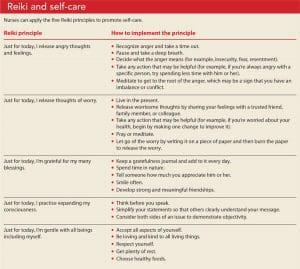

Reiki and nurse self-care
Nurses in U.S. hospitals report that their work is mentally and physically exhausting and that they suffer from burnout. Many nurses worry that their fatigue will affect patient care and consider resigning.
Once you are trained in Reiki, you can perform self- Reiki (conducting a series of hand placements on yourself) as a way to aid relaxation and improve resilience. Incorporating self-Reiki and adhering to the Reiki principles may help alleviate the stress, anxiety, sleeplessness, and pain related to the physical demands of patient care. (See Reiki and self-care.)
Attention and devotion
Reiki practice with patients can be a useful complement to Western medicine. With careful attention and devotion to each of the Reiki principles, you can provide adjunctive patient care and improve your own well-being.
Cynthia Walters is an assistant clinical professor at Duquesne University in Pittsburgh, Pennsylvania. Heather Konstanzer is an RN at Mission Hospital in Asheville, North Carolina. Julia Rodriguez is an RN at West Penn Hospital in Pittsburgh, Pennsylvania.
To learn more about Reiki and how you can incorporate it into your nursing practice, visit these websites:
• International Association of Reiki Professionals®
• The Center for Reiki Research
• The International Center for Reiki Training
Selected references
American Nurses Association. Executive Summary: American Nurses Association Health Risk Appraisal. 2017. nursingworld.org/~495c56/globalassets/practiceandpolicy/healthy-nurse-healthy-nation/anahealthriskappraisalsummary_2013-2016.pdf
Eden D, Feinstein D. Energy Medicine: Balancing Your Body’s Energies for Optimal Health, Joy, and Vitality. New York, NY: The Penguin Group; 2008.
McManus DE. Reiki is better than placebo and has broad potential as a complementary health therapy. J Evid Based Complementary Altern Med. 2017;22(4):1051-7.
Thrane S, Cohen SM. Effect of Reiki therapy on pain and anxiety in adults: An in-depth literature review of randomized trials with effect size calculations. Pain Manag Nurs. 2014;15(4):897-908.

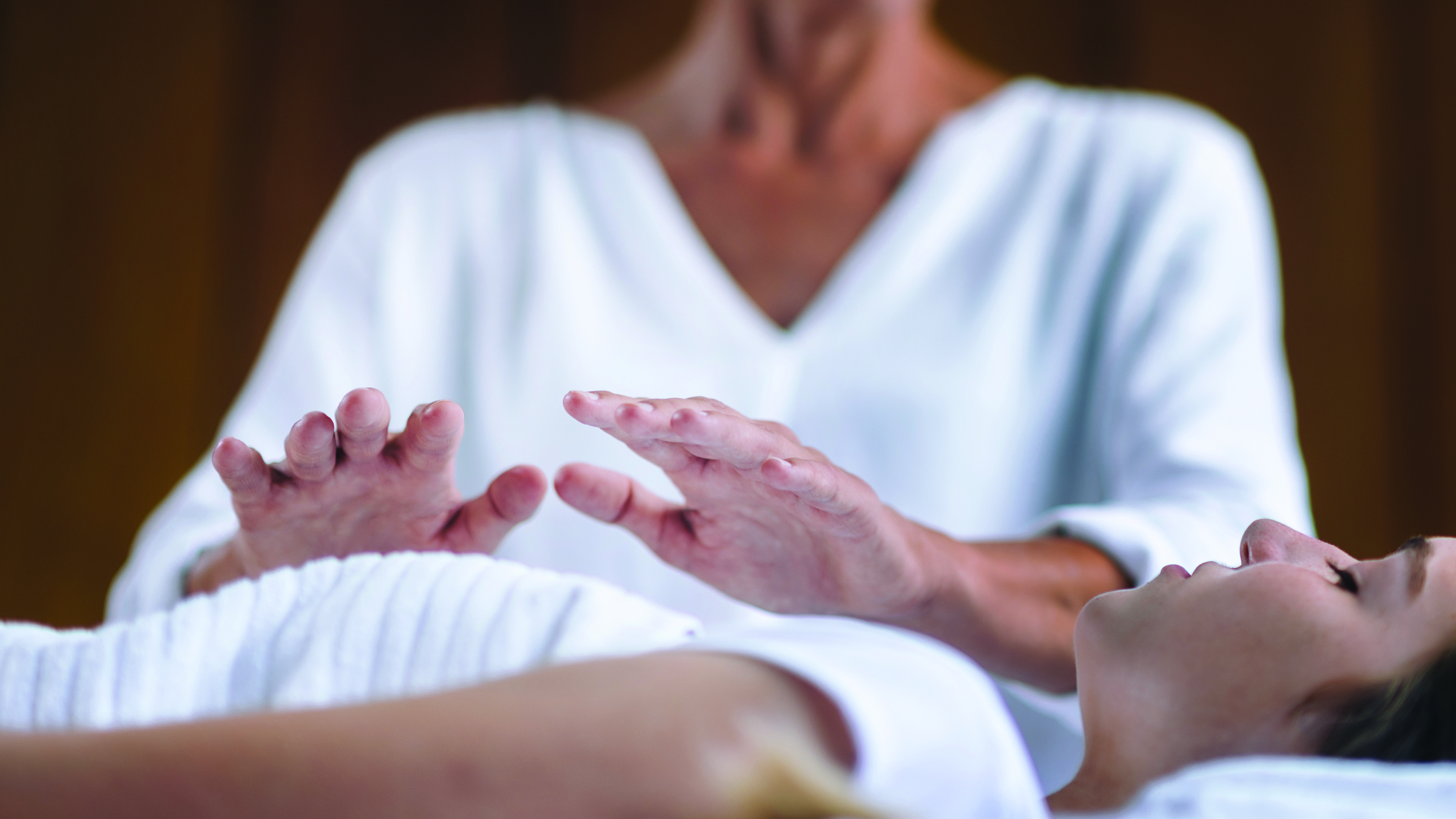


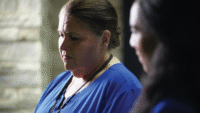
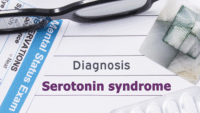
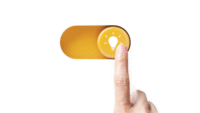
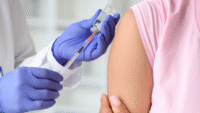





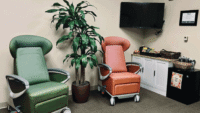
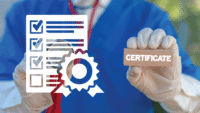



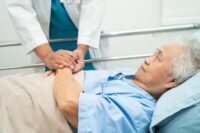
10 Comments.
My Reiki I and II classes cost a total of $300. It has been very helpful for me. I took both classes after my retirement from 45 years of nursing. My training has been beneficial for family and friends. I have had quite a varied career in health care. I feel I have learned a new technique to enhance the role I will always fill, Nurse Educator.
Thank you for sharing.
Sadly Reiki has become another a marketable tool to get money out of people’s pockets. It costs thousands of dollars to become a Reiki practitioner of all stages and then the vicious circle continues when those Reiki practitioners put a price tag on their healing services. Yet every human being is capable of healing themselves and others because we are working with the universal energy that permeates everything in the universe and is part of every living being and creature. Learning Reiki healing technique and meditation must be a part of the school curriculum and not a marketable job.
It’s very similar to what happened when Nikola Tesla, a Serbian-American inventor and electrical engineer was looking for funding to build the tower to transmit free wireless energy to the entire world for perpetuity, J. P. Morgan refused him because he couldn’t meter the power in order to sell it. Because of our own selfishness humanity still uses oil, gas and coal destroying the Earth. And so now we are trying to make profit on the universal energy through healing.
Many hospital, hospice centers and cancer retreat centers have a staff of volunteers who provide Reiki for free. Do you provide your services or do you work at your job for free?
While I strive to make an income with the skill that I invested time and money in learning and have spent years developing my experience in, I also offer free services to those in need of them and volunteer for a hospice.
Isn’t Reiki a pseudo-science and pseudo-medicine?
Is Reiki a billable service nurses can provide in hospital?
I wish I had taken Reiki before I had to retire early due to stress and pain. Susie Ohio
You might take Reiki, even now, Susan. It will help you deal with your own pain. And who kows, you may find a new rewarding way to help others still. I am doing that even at 72. I have a new expanded life focus!
Thanks so much for sharing this with me, I really appreciate the fact that you have been thinking about the Truth. (The Body is an Instrument, and to be shared as Such) ???